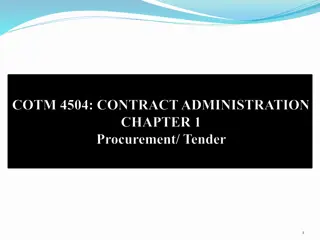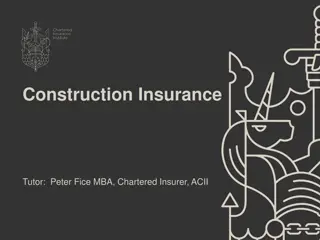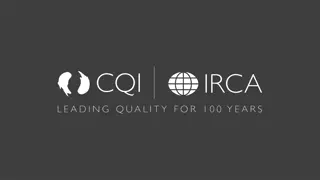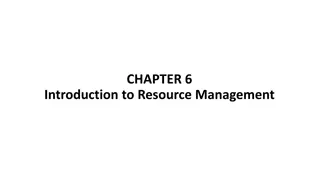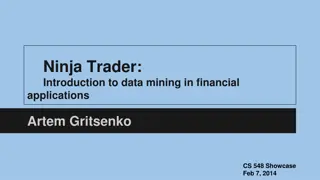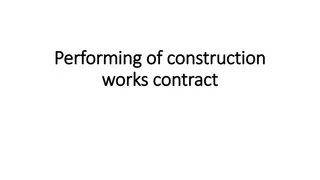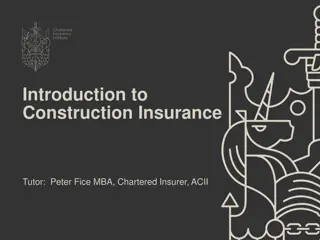Financial Strategies for the Construction Industry
Discover key financial considerations in the construction industry, from managing cash flow during growth to handling temporary cash shortages. Explore insights on billing practices, cost management, capital sourcing, and job close-out procedures. Learn about common challenges such as unpaid invoices, underbilling, and balancing risk and reward in a competitive market.
Download Presentation

Please find below an Image/Link to download the presentation.
The content on the website is provided AS IS for your information and personal use only. It may not be sold, licensed, or shared on other websites without obtaining consent from the author. Download presentation by click this link. If you encounter any issues during the download, it is possible that the publisher has removed the file from their server.
E N D
Presentation Transcript
Construction industry Show me the money Why am I not getting paid? Cash during growth an example What do I do when I am temporarily short of cash Capital sourcing to finance growth
Cyclical During bad times, we take jobs we shouldn t During good times, we hire people we shouldn t Competitive Entrepreneurial Next great opportunity is just around the corner Risk/reward imbalance
VOLUME KILLS VOLUME KILLS CASH THRILLS CASH THRILLS
Unbilled (unapproved?) change orders Underbillings Aging receivables Precon Self-performed work versus subcontracting Equipment Overhead
Expansion Non-core investments
Is your bill easy to pay? Back-up is complete Percentage completion agreed upon Collections Who is responsible for collections? Relationships, relationships, relationships When to ask for help Job Close-Out and Retention
FYE 2008 FYE 2010 (000s omitted) Annual Revenues 55,000 60,000 Accounts Receivable AR Retentions & Other Cost > Billings CURRENT ASSETS TOTAL ASSETS 9,500 4,500 2,500 16,500 23,500 10,500 6,000 5,000 21,500 26,500 Bank Debt Accounts Payable Accrued Expenses CURRENT LIABILITIES TOTAL LIABILITIES Total Equity TOTAL LIABS. & EQUITY 0 4,500 10,000 1,500 16,000 19,000 7,500 26,500 8,000 2,500 10,500 13,500 10,000 23,500 Sample balance sheet loosely based on a real company.
FYE 2008 FYE 2010 (000s omitted) Annual Revenues Top 7 Jobs from WIP report All the rest 55,000 18,500 36,500 60,000 25,000 35,000 34% 66% 42% 58% AR Retentions & Other Top 7 Jobs from WIP report All the rest 5,000 1,900 3,100 6,000 2,900 3,100 38% 62% 48% 52% Cost > Billings Top 7 Jobs from WIP report All the rest 2,500 1,300 1,200 5,000 2,900 2,100 52% 48% 58% 42%
1,000,000 900,000 800,000 700,000 600,000 Total Cost 500,000 Collections 400,000 Borrowing Requirements 300,000 200,000 100,000 0 Mo 0 Mo 1 Mo 2 Mo 3 Mo 4 Mo 5 Mo 6 Mo 7 Mo 8 Mo 9 Mo 10 Mo 11 Mo 12 (100,000)
6,000,000 5,000,000 Borrowing Requirement 60 DSO 4,000,000 Borrowing Requirement 90 DSO 3,000,000 2,000,000 1,000,000 0 Q1 Q2 Q3 Q4 Q1 Q2 Q3 Q4 (1,000,000)
Know that you are not alone Relationships with subcontractors and suppliers Relationship with banks Defer some payments
Burke Capital Corporations 5 principles: It s always about the relationship Beauty is in the eye of the beholder Be prepared Cast a wide net Competition brings out the best
Strategic growth is a great thing Long-term sustainable (and profitable) growth creates competitive advantage Always keep the next cycle in mind There are legitimate reasons for using external capital
Jim Burke Burke Capital Corp. jmburke@burkecapital.net 650 Jim Burke Burke Capital Corp. jmburke@burkecapital.net 650- -579 Michael Ong Burke Capital Corp. mong@burkecapital.net 650 Michael Ong Burke Capital Corp. mong@burkecapital.net 650- -988 579- -5699 5699 988- -9650 9650 Sandra Waechter Waechter LLC sandra@swaechter.com 650 Sandra Waechter Waechter LLC sandra@swaechter.com 650- -868 868- -0681 0681



